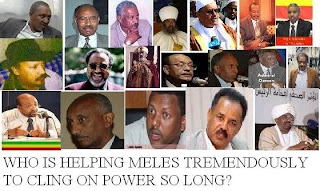

http://www.bloomberg.com/
Dec. 29 (Bloomberg) -- Ethiopian federal police re-arrested opposition leader Birtukan Mideksa a year after she was released on a pardon following her arrest during the country’s disputed 2005 elections.
Mideksa, a leader of the now-dissolved Coalition for Unity and Democracy, was taken into custody today, said Temesgen Zewde, a lawmaker, who is a member of Mideksa’s new party, Unity for Democracy and Justice.
“She has been arrested,” Zewde said in an interview in the capital, Addis Ababa. “No charges have been made public yet. We don’t know exactly where she is being held.”
Mideksa was arrested after refusing to acknowledge that she had requested a pardon that led to her release from jail in July 2007, said Bereket Simon, a spokesman for Prime Minister Meles Zenawi. She and dozens of other opposition leaders were initially jailed following the 2005 elections and sentenced to life in prison following a May 2007 trial on treason charges.
Security forces killed at least 193 protesters in Addis Ababa in the aftermath of the 2005 elections. Mideksa was jailed along with 126 other opposition leaders, journalists, and activists after disputing government claims of victory in the ballot.
Her release along with 37 others in July of 2007 came after the opposition leaders signed a letter admitting “mistakes committed both individually and collectively,” according to an Amnesty International report.
Life Sentence
Simon suggested Mideksa could again face life in prison.
“She said she didn’t ask for a pardon and the government tried to advise her that she has been freed from jail because of the requested pardon,” Simon said, in a phone interview from Addis Ababa. “She didn’t budge. Technically and legally the verdict has to be implemented.”
Mideksa and other leaders were released in two pardons authorized by Zenawi in July and August of 2007 after mediation by Ethiopian elders. Some opposition leaders, including former Addis Ababa mayor-elect Berhanu Nega, have chosen exile in the U.S. and Europe. Mideksa stayed on in Ethiopia and had planned to contest the 2010 national elections with her new party.
A lawyer and former judge, Mideksa has drawn support from Oromos and Amharas, Ethiopia’s two largest ethnic groups. Zenawi’s government, which has ruled Ethiopia since 1991, is dominated my members of the Tigray ethnic group.
Fifteen members of another opposition party, the Oromo Federalist Democratic Movement, were arrested in late October and early November and accused of supporting the separatist Oromo Liberation Front. The move comes as Ethiopia’s parliament is set to approve a new law that would effectively outlaw most non-governmental groups from promoting human rights, democracy, or conflict resolution.
To contact the reporter on this story: Jason McLure in Addis Ababa via the Johannesburg bureau at abolleurs@bloomberg.net.






